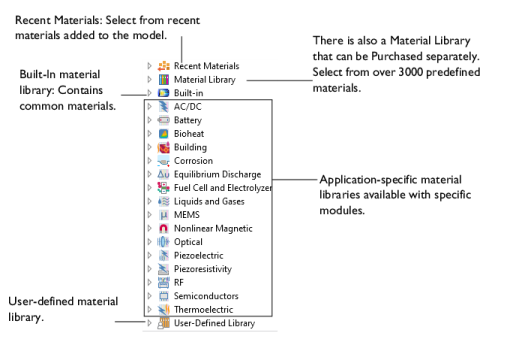
|
•
|
Recent Materials: From the Recent Materials folder (
|
|
•
|
Material Library. An optional add-on library, the Material Library, contains data for over 2500 materials and 20,000 property functions.
|
|
•
|
Built-In. Included with COMSOL Multiphysics, the Built-In library contains common materials with primarily electrical, structural, and thermal properties. The materials in this library can be considered as examples of common materials with typical values for their material properties. The Air and Water, liquid materials use the same temperature- and pressure-dependent property values as the corresponding values in the Liquids and Gases Material Library.
|
|
•
|
AC/DC. Included in the AC/DC Module, the AC/DC library has electric properties for some magnetic and conductive materials.
|
|
•
|
Battery. Included in the Battery Design Module, the Battery library includes properties for electrolytes and electrode reactions for certain battery chemistries.
|
|
•
|
Bioheat: Included in the Heat Transfer Module, the Bioheat library includes properties for several biological tissues such as bone, fat, human and porcine liver, lung, muscle, myocardium, prostate, and skin.
|
|
•
|
Building: Included in the Heat Transfer Module, the Building library includes hygroscopic and thermal properties for several materials used for structure, sheathing, thermal insulation, and vapor barriers in buildings.
|
|
•
|
Corrosion: Included in the Corrosion Module, the Corrosion library includes polarization data for several different metals and alloys in various electrolytes.
|
|
•
|
Equilibrium Discharge: Included in the Plasma Module.
|
|
•
|
Fuel Cell and Electrolyzer. Included in the Fuel Cell and Electrolyzer Module, the Fuel Cell and Electrolyzer library includes properties for electrolytes for some common cell chemistries contains electrolyte properties, such as properties for alkaline, molten carbonate, polymer, and solid oxide electrolytes.
|
|
•
|
Liquids and Gases: Included in the Acoustics Module, CFD Module, Battery Design Module, Chemical Reaction Engineering Module, Heat Transfer Module, MEMS Module, Microfluidics Module, Pipe Flow Module, and Subsurface Flow Module, the Liquids and Gases library includes transport properties and surface tension data for liquid/gas and liquid/liquid interfaces.
|
|
•
|
MEMS: Included in the MEMS Module and Structural Mechanics Module, the MEMS library has properties for MEMS materials: metals, semiconductors, insulators, and polymers.
|
|
•
|
Nonlinear Magnetic: Included in the AC/DC Module and the RF Module, the Nonlinear Magnetic library has properties, such as nonlinear magnetization curves, for a large set of ferromagnetic alloys like various types of steel.
|
|
•
|
Optical: Included with the Ray Optics Module and Wave Optics Module, the Optical library contains frequency-dependent refractive index properties for organic and inorganic materials, glasses, and other materials such as semiconductors.
|
|
•
|
Piezoelectric: Included in the Acoustics Module, MEMS Module, and Structural Mechanics Module, the Piezoelectric library has properties for piezoelectric materials.
|
|
•
|
Piezoresistivity: Included in the MEMS Module, the Piezoresistivity library has properties for piezoresistive materials, including p-type and n-type silicon materials.
|
|
•
|
RF: Included in the RF Module, the RF library includes material properties for substrate materials to assist in modeling RF, microwave, and millimeter-wave circuit boards.
|
|
•
|
Semiconductors: Included in the Semiconductor Module, the Semiconductors library contains silicon, germanium, gallium arsenide, AlxGa1-xAs, gallium nitride (wurtzite and zincblende structures), gallium phosphide, gallium antimonide, indium arsenide, indium phosphide, and indium antimonide materials for use with this module.
|
|
•
|
Thermoelectric: Included with the Heat Transfer Module and contains bismuth telluride and lead telluride materials for use with the Thermoelectric Effect interface.
|
|
•
|
User-Defined Library: The User-Defined Library folder (
|